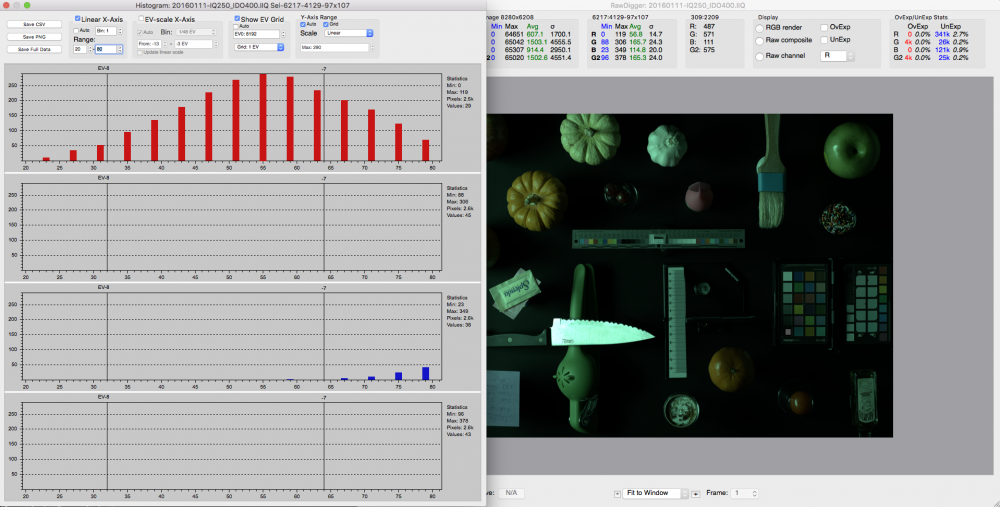-
Posts
779 -
Joined
-
Last visited
Content Type
Profiles
Forums
Articles
Everything posted by Robert Collins
-
I dont know what your problem is BUT he is a 1Dx ii user who had the A7iii 'for about a week'. It is almost certainly littered with 'new toy' exaggerations although he did at least vlog with the camera.. But the Op here asked for opinions. And I dont know who is better to give opinions than someone who has used both cameras. Admittedly a week isnt a long time but it is fairly long in terms of the A7iii when the camera was only released in the US two weeks ago. If you happen to be better qualified to give your opinions go ahead....
-
Here's a decent video on the subject.... My take on it.... 1) The fact that we are comparing a US$2000 Sony against a US$6000 Canon really speaks volumes about the Sony. If the switch in terms of camera + lenses is a wash then the Sony sets you up better in the future - a US$2000 replacement or a US$6000 replacement (using a Sony body with Canon lenses and expecting good video af would be heroically optimistic.) 2) If you dont value ibis (which allows a lot of handheld especially at 120p) or the fact that you can use a smaller gimbal isnt of much interest, there isnt a lot of incentive to change 3) If 4k/60 or Canon colors are a dealbreaker the same applies.
-
My settings on my A7riii are incredibly close to these - even the color adjustments are within 2 points on each color. I do have detail set to 0 on 120p (-6 4k).
-
Does 'face registration' not work in video mode?
-

Now mirrorless is a raging success. Samsung will be back
Robert Collins replied to Andrew Reid's topic in Cameras
'Upgraded my phone' is a pretty 'odd' expression that we all use. I mean absolutely noone has ever said 'I just bought a new phone and my phone calls now are just so much clearer'. The biggest 'delta' in a new phone these days is the camera. I would guess that Samsung sees itself - not as a company that has 'exited' the camera business - but as the biggest camera manufacturer in the world. I dont think that 'proper cameras' will become 'more niche' they are already outnumbered by smartphones 100:1. Here in Asia I feel there are more 'proper cameras' being bought now, as people get bitten by the 'photo/video' bug and then look for something better. But I dont really have any hard numbers to justify that. -

Now mirrorless is a raging success. Samsung will be back
Robert Collins replied to Andrew Reid's topic in Cameras
Data for digital cameras come from CIPA 2017 http://www.cipa.jp/stats/documents/e/d-201712_e.pdf Actually they show the entire digital camera market at 800 billion yen or about US$8bn (but that is at shipping values which would be lower than retail.) Mirrorless is 220 billion yen or US$2bn. Yes its growing but I do think it is really about splitting up the digital camera pie which is why Canon/Nikon is interested in mirrorless. Arguably Canon/Nikon/ Panasonic/Sony/Ollympus/Fuji are just fighting over a US$2bn market. Total number of interchangeable lens cameras sold in 2017 = 11m (CIPA). Total number of smartphones sold in 2017 1,536m = a multiple of 140x!! https://www.gartner.com/newsroom/id/3859963 The cold reality is that Samsung is not in the digital camera market because they are in the smartphone market - and the cold reality is that Panasonic/Canon/Nikon/Sony/Olympus are in the digital camera market because they are not in the smartphone market. -

Now mirrorless is a raging success. Samsung will be back
Robert Collins replied to Andrew Reid's topic in Cameras
Unfortunately, this is exactly the point. It is why every Samsung fanboy would like a new camera from them and exactly why they wont introduce one. If you produce the 'best hybrid on the market' and the resulting sales are so low that CIPA doesnt even record them, you might as well give up - which is exactly what they did. A huge shrug and moving on isnt exactly the best incentive to return to a market. -
I wonder if the modern digital camera manufacturers are missing a trick here. It seems the desire for a more 'filmic' look for video is fairly universal. However if I go through the 10 picture profiles on say my Sony, I basically find an odd mix of either 'digital video' looks or 's-log' which is really an attempt to give you as much leeway in post to create your own look (which isnt a lot with an 8 bit file.) What I dont see is much attempt at creating 'creative profiles' that match what would be considered a 'filmic look' straight out of camera (or with limited tweaking.) Seems this is the route that Fuji has gone down with the x-h1 and the Eterna profile and it has been generally well received.
-

Now mirrorless is a raging success. Samsung will be back
Robert Collins replied to Andrew Reid's topic in Cameras
I dont see it myself. The numbers dont really add up. The digital camera market (ILC/compacts) is a US$10bn a year market of which Canon/Nikon/Sony hold 85%. If Samsung re-entered the market and we heroically optimistically assumed they gained a 10% share - it would only amount to US$1bn a year - less than 0.5% of Samsungs US$200bn+ annual sales. Compare that to the US$500bn a year smartphone industry. However there are, I think, two 'possibilities that could bring Samsung back into the market. First, Samsung and Nikon are almost a 'perfect' fit. Samsung key competencies are electronics and Nikon's core competency is photography - ideal when cameras are turning into electronic products. Samsung brings image sensors, image processing, lcds etc and Nikon brings lenses, brand, market share and distribution. Furthermore, Nikon is ultimately going to be seriously disadvantaged long term relying on Sony for sensors (Sony being a major and growing competitor in cameras). So a joint venture/strategic partnership between the two makes a lot of sense (assuming that Samsung is interested in the digital camera to showcase its tech.) Second, and related to this, Samsung could quite easily acquire Nikon. Samsung is a US$300bn market cap company and Nikon is a US$6bn market cap. company. So acquiring Nikon is chicken feed to Samsung. So if Samsung wants to reenter the market, it makes a lot of sense to buy into the market rather than try to recreate their market share from scratch. But even the Nikon/Samsung tie up in one form or another I see as pretty unlikely because Samsung really hasnt shown a lot of ambition in the image sensor market (despite some press reports to the contrary.) Take the flagship S9/S9+ as an example. It continues to use both Samsung and Sony image sensors (and people dont seem able to tell the difference.) https://***URL removed***/news/0634864640/tech-insights-teardown-confirms-galaxy-s9-uses-samsung-and-sony-image-sensors So if Samsung cant be bothered to showcase their image sensor tech in their flagship smartphones, I dont think they are likely to do it in digital cameras. -
If you happen to stupid enough, like me, to buy into kickstarter projects, you would realize that a company's ability to realize a project is inversely proportional to the attractiveness of the price, specs and timing of the product they promise.
-

so the iMac Pro is not really professional after all?
Robert Collins replied to no_connection's topic in Cameras
I see 'professional' and 'closed' system as an oxymoron. Who in their right mind uses a computer whose lifespan is determined by the shortest lifespan of any given component. I gave up using Macs for desktops when Apple stopped making desktops (which is a while ago.) -
The D610 is coming up to 5 years old!!
-
I am sorry. Just because you think it is ‘perfectly acceptable’ doesn’t make it so. You finance your manufacturing costs through ‘finance’ not through interest free, unsecured loans from your customers. What you consider ‘perfectly acceptable’ is actually illegal in some countries. The exception is say Kickstarter where the contract is made explicit that your payment is an unsecured loan.
-
I agree. The 14 bit raw still files out of my A7riii, I can very nearly do anything with easily in post - so much so I hardly need to get it right in camera. On the opposite end of the scale, my Mavic's 60mb/s 8bit footage needs to be pretty much spot on in camera and it is difficult to do much other than tweak in post. And I find 8 bit slog out of the Sony too difficult to handle in post without banding issues (hopefully more down to inexperience rather than incompetence.)
-
Interesting. Absolutely no idea if it is true of either the GH5s or BMPCC but here is the pdf flyer of the sensor. https://www.sony-semicon.co.jp/products_en/IS/sensor0/img/product/cmos/IMX294CJK_Flyer.pdf Couple of points. 1) It is a standard 4:3 sensor with a 21.63mm diagonal - so if it is in the GH5s it isnt using an 'oversized' sensor as many people had indicated. 2) The sensor is capable of 4k/120 although only in 10 bit (as opposed to 12)
-
Overall I think Sony are fine. They are in the big sensor market with the A7 - cos they sell sensors. With hybrid ILCs they are very well positioned - their stills are pretty much second to none and they have a strong competitive advantage here. Their video scores as 'good enough' for most prosumers - ok ibis, decent af and no/little crop factor (And certainly good enough when compared to their FF competitors.) But when it comes to the video only/mostly crowd I think it is fairly obvious that FF isnt the sweet spot. You cant currently fit 4k/60, 12 bit raw etc into a small body with a big sensor. So I dont know where this leaves the A7s series or where there is even room for the A7siii especially as Sony chose not to cripple the video in the A7iii.
-

Sony FS5 II announced with 4K 120fps RAW recording at NAB 2018
Robert Collins replied to Andrew Reid's topic in Cameras
Well the latest rumor is that they are going to put a 'stacked' sensor similar to the A9 with a blazing fast sensor readout (A9 is 1/160th for stills). This would all but eradicate rolling shutter. That tech is very expensive though and would easily make the camera US$3500. -

Sony FS5 II announced with 4K 120fps RAW recording at NAB 2018
Robert Collins replied to Andrew Reid's topic in Cameras
Nearly every time a camera comes out you see compromises due to heat problems - say the Fuji XH-1. Its quite possible that the FS5ii is crippled to protect the FS7. But I actually think the heat issues mean we are a 'long way' from seeing 10 bit internal or 4k 60 in an A7siii body with stabilization. I just think with current technology the sensor is too large and the body too small. I am not even sure Sony can bring this to APSC. -

Sony FS5 II announced with 4K 120fps RAW recording at NAB 2018
Robert Collins replied to Andrew Reid's topic in Cameras
I think it is time to give up on the prospect of an A7siii. I feel it is either not going to arrive or arrive with underwhelming specs. If it does arrive, I suspect its stand out feature will be a stacked sensor with fast readout speed that virtually eliminates rolling shutter. That's fine but it is a very expensive solution to what isnt a major problem for 'me'. -
OK perhaps you missed my point. The suggestion was that Nikon introduce 16 bit files. As Sony (and others) only produce FF sensors with a maximum of 14 bit digital output, Nikon could only provide 16 bit files by 'padding' the last 2 bits (which is what a lot of the MF cameras are doing). It would still be 14 bits of information in a 16 bit container. To me this sounds like a lousy idea. It is pretty obvious, though, that it will fool some people into believing they have magically created information where none exists!! So I definitely see the marketing angle.
-
Honestly that is nonsense. Look at the raw digger data from Phase One IQ250 It very clearly shows a 16 bit file with 14 bit information - which is why 3 out of 4 channels are blank. I am not sure if we are discussing whether it is possible to create 16 bit files from 14 bits of information (which is trivial) or whether you actually think it is a good idea on the basis that it fools you into thinking you have 16 bits of information.
-
It really isnt that simple. I can take an 8 bit jpeg into photoshop and convert it to 16 bit - it will be a 16 bit file with 8 bits of information. The 50mp Sony medium format sensor only outputs 14 bit data, so any 16 bit file generated from the data has simply added 'padding'. For instance the Hasselblad X1D claims to be 16 bit while the Fuji GFX 50s is 14 bit. As you can see here the only difference is the padding in the Hasselblad. https://***URL removed***/forums/post/59002429 Sony (or anyone else) do not actually produce a FF sensor with more than 14 bit output. Now Nikon's image processor could quite easily convert that to 16 bit but it wouldnt actually achieve anything of any consequence. Apart from the fact that it might be a good marketing ploy if it happened to fool people.
-
Out of interest have you ever managed to generate banding from a 14bit raw file or even a 12 bit raw file for that matter? And even if you have, it may well reflect the fact that you have a 8 bit computer screen (or possibly 10 bit). (I struggle to see the difference between 12 and 14 bit 99%+ of the time and I push the files pretty hard.) In any case, most of the engineers suggest that the 16 bit files from medium format cameras are simply 'padding' 14 bit digital output.
-
In my experience, PC v Mac threads never really die until people end up debating the benefits of Linux
-
Mac Pro update delayed until 2019 https://***URL removed***/news/5093932298/report-apple-won-t-release-the-next-mac-pro-until-2019





